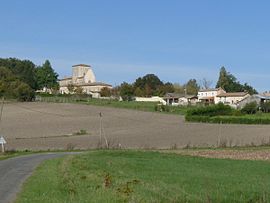Chatenet | |
|---|---|
 A general view of Chatenet | |
| Coordinates: 45°18′09″N 0°18′19″W / 45.3025°N 0.3053°W | |
| Country | France |
| Region | Nouvelle-Aquitaine |
| Department | Charente-Maritime |
| Arrondissement | Jonzac |
| Canton | Les Trois Monts |
| Intercommunality | Haute-Saintonge |
| Government | |
| • Mayor (2020–2026) | Philippe Chaillou[1] |
| Area 1 | 9.6 km2 (3.7 sq mi) |
| Population (2021)[2] | 212 |
| • Density | 22/km2 (57/sq mi) |
| Time zone | UTC+01:00 (CET) |
| • Summer (DST) | UTC+02:00 (CEST) |
| INSEE/Postal code | 17095 /17210 |
| Elevation | 61–123 m (200–404 ft) (avg. 85 m or 279 ft) |
| 1 French Land Register data, which excludes lakes, ponds, glaciers > 1 km2 (0.386 sq mi or 247 acres) and river estuaries. | |
Chatenet (French pronunciation: [ʃatnɛ]) is a commune in the Charente-Maritime in the department in the Nouvelle-Aquitaine region in southwestern France.
Geography
[edit]Chatenet is a small commune situated between the market town of Montendre and the large village of Chevanceaux. It is principally a farming community; however in recent years tourism has become important. The location of Chatenet in the southern tip of the Charente Maritime provides the area with a warm climate. The Seugne flows north-northwestward through the middle of the commune and forms part of its southern and northern borders.
Population
[edit]| Year | Pop. | ±% |
|---|---|---|
| 1962 | 268 | — |
| 1968 | 275 | +2.6% |
| 1975 | 215 | −21.8% |
| 1982 | 210 | −2.3% |
| 1990 | 195 | −7.1% |
| 1999 | 188 | −3.6% |
| 2008 | 220 | +17.0% |
See also
[edit]References
[edit]- ^ "Répertoire national des élus: les maires". data.gouv.fr, Plateforme ouverte des données publiques françaises (in French). 2 December 2020.
- ^ "Populations légales 2021" (in French). The National Institute of Statistics and Economic Studies. 28 December 2023.
External links
[edit] Media related to Chatenet at Wikimedia Commons
Media related to Chatenet at Wikimedia Commons



Well, that’s interesting to know that Psilotum nudum are known as whisk ferns. Psilotum nudum is the commoner species of the two. While the P. flaccidum is a rare species and is found in the tropical islands. Both the species are usually epiphytic in habit and grow upon tree ferns. These species may also be terrestrial and grow in humus or in the crevices of the rocks.
View the detailed Guide of Psilotum nudum: Detailed Study Of Psilotum Nudum (Whisk Fern), Classification, Anatomy, Reproduction